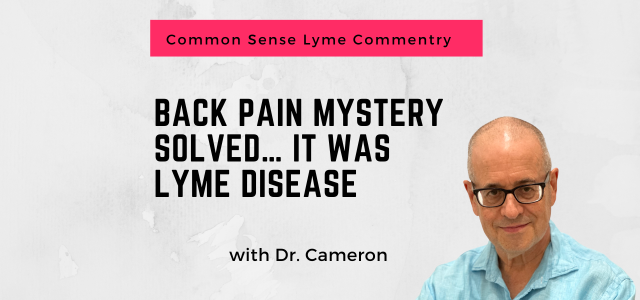Call for your appointment today 914-666-4665 | Mt. Kisco, New York

Back pain is one of the most common complaints in medicine. For most people, it’s caused by something mechanical—disc degeneration, a pinched nerve, or muscle strain. But sometimes, the cause isn’t physical at all. I had a patient whose back pain defied every explanation—until we found an answer where no one had thought to look: Lyme disease.
Surgery and Rehab: A Promising Start
My patient had a long history of lower back pain. After struggling with it for years, he underwent back surgery and engaged in a dedicated course of physical therapy. For the first time in years, he was pain-free. He felt like he had his life back. He returned to daily activities, enjoyed time with his family, and was finally free from the constant burden of discomfort.
The Pain Returns—Worse Than Before
Months later, his pain came back.
But this time, it was different. It was severe, deep, and unrelenting. He hadn’t lifted anything heavy. There was no trauma. His physical therapy routine had remained consistent. Yet the pain—centered in his lower back—grew worse by the week.
He returned to his neurosurgeon. Imaging showed no new issues—no disc herniation, no surgical complications, nothing to explain the pain.
A 9-Month Search for Answers
He was referred to pain management. Tried anti-inflammatories. Tried physical therapy again. Tried trigger point injections. Nothing helped. The pain was taking a toll—physically, emotionally, and socially. He couldn’t sleep well. He avoided movement for fear of worsening his pain.
For nine months, every path led to a dead end.
No Tick Bite. No Rash. But Something Was Off
What made this case even more puzzling was the absence of any red flags we usually look for with infections. There was no tick bite, no erythema migrans rash, and no fevers. Lyme disease wasn’t even on the radar.
But other symptoms began to appear—fatigue, low mood, brain fog, and a growing sensitivity to heat and cold. It no longer seemed like just a spine problem.
A Broader Workup—and a Surprising Diagnosis
Because his symptoms were no longer isolated to his back, we broadened the differential diagnosis. We tested for autoimmune conditions, neurologic disorders, and chronic infections.
That’s when a Lyme disease test came back positive—specifically, multiple IgG Western blot bands consistent with a late-stage infection.
The pieces started to fall into place.
How Lyme Disease Can Cause Back Pain
Lyme disease is caused by the Borrelia burgdorferi bacteria. While many associate Lyme with joint pain or flu-like symptoms, it can also cause inflammation of nerve roots—a condition known as radiculitis—which can feel exactly like sciatica or disc-related back pain.
In some patients, Lyme disease affects the central nervous system and causes neuropathic pain that does not respond to typical treatments like surgery or anti-inflammatories. And in late-stage Lyme, patients often do not recall any early signs of infection. Studies estimate that 30% or more of patients with Lyme disease never see the tick or develop a rash.
Treatment—and Recovery
Once diagnosed, my patient began antibiotic treatment tailored to neurological Lyme disease. Within a few weeks, his pain began to improve. Slowly but surely, the deep, burning back pain that had plagued him for nearly a year began to fade. So did the fatigue, brain fog, and other symptoms.
Within a few months, he was functioning well again—and back to enjoying his life.
What This Case Teaches Us
This case highlights something crucial: Lyme disease doesn’t always follow the rules.
- You don’t need to have joint swelling or fever.
- You don’t need a textbook presentation for it to be real.
- When conventional explanations fall short, it’s time to think more broadly.
Five key takeaways:
- Chronic back pain may have non-mechanical causes.
Not all back pain stems from disc problems or muscle strain. Sometimes the root cause is something unexpected—like a persistent infection such as Lyme disease. - A normal MRI doesn’t rule out a serious problem.
Imaging can appear normal even when significant symptoms are present. Lyme-related nerve inflammation may not be visible on routine scans. - Failed back surgery syndrome may not always be surgical failure.
When pain returns after a successful procedure, it may not be the spine at fault. An undiagnosed infection or inflammatory process could be the real culprit. - Pain that doesn’t respond to standard treatment deserves further investigation.
If physical therapy, injections, and medications fail, it’s time to look beyond conventional explanations and consider underlying systemic causes. - Lyme disease can cause neuropathic and radicular pain.
Lyme disease can inflame nerve roots, creating symptoms that mimic sciatica or spinal disorders—without any visible structural damage.
When to Suspect Lyme Disease in Back Pain
Consider Lyme disease in patients with unexplained back pain when:
- Imaging doesn’t match the severity of the symptoms
- Pain worsens despite appropriate treatment
- There are neurologic symptoms (numbness, tingling, burning pain)
- Fatigue, brain fog, or mood changes are also present
- The patient lives in or has visited a tick-endemic area (Northeast, Midwest, or Pacific Northwest)
Final Thoughts: Look Deeper When Pain Persists
Lyme disease can mimic many conditions. This patient’s story reminds us that when the usual explanations fall short, we must keep asking questions and consider less obvious diagnoses.
Back pain is common. But if it’s unresponsive to treatment and comes with a set of symptoms that don’t quite add up, look deeper.
Because sometimes, it’s not the spine—it’s the infection you didn’t know was there.
Related Articles:
Podcast: Severe neuropathic pain due to Lyme disease
Neck pain in child with Lyme disease due to radiculoneuritis




I’d appreciate learning more about the connections between gynaecological health issues, bladder prolapse and late stage Lyme disease. Given how this disease has destroyed collagen in the skin which is the bodies largest organ; it certainly does not stop there. Chronic UTIs compounded by multiple uses of antibiotics to control infections, creates the perfect breeding ground for mold, whether ingested or environmental. How can late stage Lyme patients find any balance in treatment?
There have found retreatment has helped some patient get better based on the hypothesis that there is a persistent tick borne infection.
I avoided hysterectomy after being diagnosed with chronic Lyme. I never did antibiotics. My doctor used alternative methods and the symptoms I was having began to disappear. Symptoms that were bewildering to my gynecologist. I of course had other symptoms, but they weren’t aware of the connection. No blame to them, after all they were very good at their specialty. I had read another woman’s story online after I was diagnosed and her story was very similar to mine. I felt like I was reading my words. It helped me to understand that I was not alone and that what I was experiencing was very real.
I have patients who live with their chronic illness ascribing every symptom to something.
I had severe thoracic back pain for Years !!!! Excruciating!!!Night sweats , vision problems , fatigue , anxiety , depression. .Mood instability and intense anxiety . Went undiagnosed for years!!! Finally an infectious disease specialist ran testing for Lyme and I ended up with an Advanced case of Lyme . Treatment with long term antibiotics removed all my symptoms except for the vision problems . LD basically destroyed my ENTIRE life for years going undetected ! . Kudos to the Drs that listen to their patients and think ” outside the box”
This disease is Horrific !
You mentioned the western blot was positive. I am wondering if you did the initial antibody test and what that showed? I have a lot of Lyme symptoms including severe joint and back pain. My antibody test came back negative but those tests are known to be unreliable.